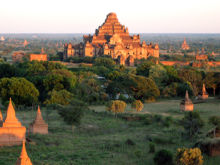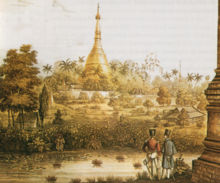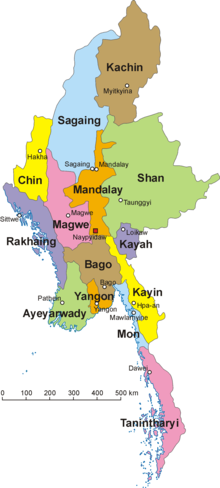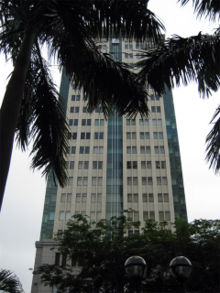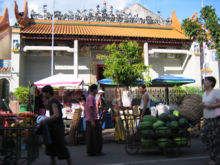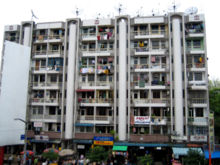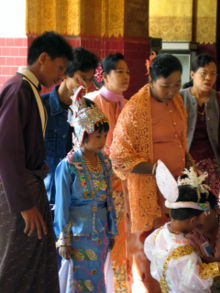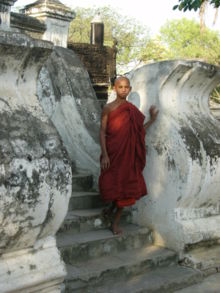Myanmar
2007 Schools Wikipedia Selection. Related subjects: Asian Countries; Countries
Pyi-daung-zu Myan-mar Naing-ngan-daw Union of Myanmar |
|||||
|
|||||
| Anthem: Kaba Ma Kyei | |||||
| Capital | Naypyidaw |
||||
|---|---|---|---|---|---|
| Largest city | Yangon | ||||
| Official languages | Myanmar (Burmese) | ||||
| Government | Military junta | ||||
| - Chairman, SPDC | Sr. Gen. Than Shwe | ||||
| - Prime Minister | Gen. Soe Win | ||||
| Independence | From the United Kingdom | ||||
| - Date | January 4, 1948 | ||||
| Area | |||||
| - Total | 676,578 km² ( 40th) 261,227 sq mi |
||||
| - Water (%) | 3.06% | ||||
| Population | |||||
| - July 2005 estimate | 50,519,0001 ( 24th) | ||||
| - 1983 census | 33,234,000 | ||||
| - Density | 75/km² ( 119th) 193/sq mi |
||||
| GDP ( PPP) | 2005 estimate | ||||
| - Total | $93.77 billion ( 59th) | ||||
| - Per capita | $1,691 ( 150th) | ||||
| HDI (2003) | 0.578 (medium) ( 129th) | ||||
| Currency | kyat (K) ( mmK) |
||||
| Time zone | MMT ( UTC+6:30) | ||||
| Internet TLD | .mm | ||||
| Calling code | +95 | ||||
| 1Estimates for this country take into account the effects of excess mortality due to AIDS; this can result in lower life expectancy, higher infant mortality and death rates, lower population growth rates, and changes in the distribution of population by age and sex than would otherwise be expected. | |||||
Myanmar, officially the Union of Myanmar (pronounced [pjìdàunzṵ mjəmà nàinŋàndɔ̀]) is the largest country by geographical area in mainland Southeast Asia. On 4 January 1948 Burma achieved independence from Great Britain as the “Union of Burma”. Subsequent name changes were on 4 January 1974 to the “Socialist Republic of the Union of Burma”; 23 Septmber 1988 to the “Union of Burma” and, since 18 June 1989, the “Union of Myanmar”. Also known as Burma or the Union of Burma by bodies and states which do not recognize the ruling military junta, it is bordered by the People's Republic of China on the north, Laos on the east, Thailand on the southeast, Bangladesh on the west, and India on the northwest, with the Andaman Sea to the south, and the Bay of Bengal to the southwest. One-third of Myanmar's total perimeter, 1,930 km (1,199 mi), forms an uninterrupted coastline.
Myanmar's diverse population has played a major role in defining its politics, history and demographics in modern times. Its political system remains under the tight control of the State Peace and Development Council, the military government led by Senior General Than Shwe since 1992. Part of the British Empire until 1948, Myanmar continues to struggle to mend its ethnic tensions and overcome coups d'état. The country's culture, heavily influenced by neighbours, is based on a unique form of Buddhism intertwined with local elements.
Etymology
The name "Myanmar" is derivative from the local short-form name Myanma Naingngandaw. . This name was used as early as the 12th century, but its etymology remains unclear. It is also the official name of the residents or citizens of Myanmar (written without the final "r" when used as an adjective, as in "the Myanma people"). "Bamar" is more specifically the official name of a person from the majority Burman ethnic group.
In 1989, the military junta officially changed the English version of its name from Burma to Myanmar, along with changes to the English versions of many place names in the country, such as its former capital city from Rangoon to Yangon. However, the official name of the country in the Burmese language, Myanmar, did not change, though this is often rendered in English as Myanma.
The renaming proved to be politically controversial. Because the military junta was not legitimately elected, some governments have contended that it did not have the authority to officially change the name in English. This stance has also been adopted by most Burmese who oppose the military regime, but who do not necessarily dispute the semantics.
The English-speaking world has been slow in accepting the name change; usage of Burma is still common. Burmese remains the most commonly used adjective. Major news organisations such as the BBC, Wall Street Journal, and The Financial Times as well as Western governments, including those of the United States and the United Kingdom, still officially refer to the country as Burma. CNN, The Economist, and The New York Times use "Myanmar" as the country name and "Burmese" as the adjective.
History
The Mon people are thought to be the earliest group to migrate into the lower Ayeyarwady valley, and by the mid 900s were dominant in southern Burma.
The Pyu arrived in the 1st century BC and established several city kingdoms which traded with India and China. The most powerful Pyu kingdom was Sri Ksetra, which was subsequently abandoned in 656. The Pyu re-established themselves, but in the mid 800s were invaded by the Nanzhao kingdom.
The Burmans, or Bamar, began migrating to the Ayeyarwady valley from present-day Tibet sometime prior to the 800s. By 849, they had established a powerful kingdom centered on Pagan. During the reign of Anawratha (1044-1077), Burman influence expanded throughout much of present-day Myanmar. By the 1100s, large portions of continental Southeast Asia were controlled by the Pagan Kingdom, commonly called the First Burmese Empire. In the late 1200s, Mongols under Kublai Khan invaded the Pagan Kingdom, but by 1364 the Burmans re-established their kingdom at Ava, where Burmese culture entered a golden age. However, in 1527, the Shan pillaged Ava. Meanwhile, the Mon re-established themselves at Pegu, which became a major commercial and religious centre.
Burmans who had fled from Ava established the Toungoo Kingdom in 1531 at Taungoo, under Tabinshwehti, who re-unified Burma and founded the Second Burmese Empire. Because of growing European influence in Southeast Asia, Toungoo Kingdom became a major trading centre. Bayinnaung expanded the empire by conquering the states of Manipur, Chiang Mai, and Ayutthaya. But internal rebellion and lack of resources to control the acquisitions led to the downfall of Toungoo Kingdom. Anaukpetlun, who had expelled Portuguese invaders, founded a new dynasty at Ava in 1613. Internal rebellion by the Mon aided by France, led to the kingdom's downfall in 1752.
Alaungpaya established the Konbaung Dynasty and founded the Third Burmese Empire in the 1700s. In 1767, King Hsinbyushin conquered Ayutthaya kingdom which resulted in Thai culture greatly enriching that of the Burmans. The Qing Dynasty of China, fearful of growing Burman power, invaded four times from 1766 to 1769 without success. Later monarchs lost control of Ayutthaya, but acquired Arakan and Tenasserim.
During the reign of King Bagyidaw, in 1824, Mahabandoola captured Assam, adjacent to British territory in India, prompting war. The First Anglo-Burmese War was concluded by a peace treaty in Yandabo, in Central Myanmar, in 1826. The coastal territories of Rakhine (Arakan) and Tanintharyi. In 1851, King Tharawaddy imprisoned some British officials after border skirmishes, which the British used as the pretext for the Second Anglo-Burmese War. This time, the British annexed the remaining coastal provinces - Ayeyarwady, Yangon and Bago. In 1885, Burmese tax collectors, acting for the King, found out that the Bombay-Burma Teak Company had been illegally logging teak and hiding them in hope of evading tax. The King, Thibaw Min, slapped a fine on the company, which was seen by the British as a opportunity to annex the rest of Burma. In November 1885, the Third Anglo-Burmese War was waged, for a period of only two weeks. Thibaw Min and the Royal family were detained and exiled to Madras, and finally Ratnagiri. Burma became a province of British India by late November 1885, and was given as a New Year present to Queen Victoria on 1st January, 1886. On 1 April 1937, Burma became a separately administered territory, independent of the Indian administration. The vote for keeping Burma in India, or as a separate colony "khwe-yay-twe-yay" divided the populace, and laid the ground work for the insurgencies to come after independence. In the 1940s, the Thirty Comrades, led by Aung San, founded the Burma Independence Army The Thirty Comrades received training in Japan.
During World War II Burma became a major front in the Southeast Asian Theatre. Initially the Japanese-led Burma Campaign succeeded and the British were expelled from most of Burma, but the Allies retaliated. By July 1945 they had retaken the country. The Burmese fought for both sides in the war. Although many Burmese fought initially for the Japanese, some Burmese also served in the British Burma Army in 1941-1942. In 1943, the Chin Levies and Kachin Levies were formed in the border districts of Burma still under British control. The Burma Rifles fought as part of the Chindits under General Orde Wingate from 1943-1945. Later in the war, the Americans created American-Kachin Rangers which also fought for the Allies. Many other Burmese fought with the British Special Operations Executive. The Burma Independence Army under the command of Aung San and the Arakan National Army fought with the Japanese from 1942-1944, but rose up against the Japanese in 1945.
In 1947, Aung San became Deputy Chairman of the Executive Council of Burma, a transitional government. But in July 1947, political rivals assassinated Aung San and several cabinet members. On 4 January 1948, the nation became an independent republic, named the Union of Burma, with Sao Shwe Thaik as its first President and U Nu as its first Prime Minister. Unlike most other former British colonies, it did not become a member of the Commonwealth. A bicameral parliament was formed, consisting of a Chamber of Deputies and a Chamber of Nationalities. The geographical area Myanmar encompasses today can be traced to the Panglong Agreement, which combined Burma Proper, which consisted of Lower Burma and Upper Burma, and the Frontier Areas, which had been administered separately by the British.
In 1961 U Thant, then Burma's Permanent Representative to the United Nations and former Secetary to the Prime Minister, was elected Secretary-General of the United Nations; he was the first non-Westerner to head any international organization and would serve as UN Secretary-General for ten years. Among the Burmese to work at the UN when he was Secretary-General was a young Aung San Suu Kyi.
Democratic rule ended in 1962 with a military coup d'état led by General Ne Win, who ruled for nearly 26 years and pursued policies under the Burmese Way to Socialism. In 1974, the funeral of U Thant led to bloody anti-government protests.
In 1988, the 8888 Uprising pushed the country to the brink of revolution. In response, General Saw Maung staged a coup d'état. He formed the State Law and Order Restoration Council (SLORC). In 1989, martial law was declared after widespread protests. Plans for People's Assembly elections were finalised on 31 May 1989.
In 1990, free elections were held for the first time in almost 30 years. The NLD, the party of Aung San Suu Kyi, won 409 out of a total 489 seats, but the election results were voided by SLORC, which refused to step down. SLORC renamed Burma 'Myanmar' in the English language in 1989. Led by Than Shwe since 1992, the military regime has made cease-fire agreements with most ethnic guerrilla groups. In 1992, SLORC unveiled plans to create a new constitution through the National Convention, which began 9 January 1993. In 1997, the State Law and Order Restoration Council was renamed the State Peace and Development Council (SPDC).
On 23 June 1997, Myanmar was admitted into the Association of Southeast Asian Nations. The National Convention continues to convene and adjourn. Many major political parties, particularly the National League for Democracy, have been excluded, and little progress has been made. On 27 March 2006, the military junta, which had moved the national capital from Yangon to a site near Pyinmana, officially named it Naypyidaw, meaning "seat of kings". In September of 2006, The U.S. led effort to include Burma on the United Nations Security Council Agenda finally passed allowing the U.N.S.C. to discuss officially how it will deal with the human rights situation in Burma. In November of 2006, the International Labor Organization announced it will be seeking charges against Myanmar over the continous forced labor of it's citizens by the military at the International Court of Justice .
- List of capitals of Myanmar
- Pagan 1044-1287
- Sagaing 1315-1364, 1760-1764
- Ava 1364-1750, 1764-1782
- Shwebo 1750-1753
- Rangoon (Yangon) 1753-1760, 1937-2006
- Amarapura 1782-1823, 1841-1857
- Mingun 1857-1861
- Mandalay 1861-1886
- Naypyidaw from 19 Feb 2006
Politics
The Union of Myanmar is a military regime. Elected delegates in the 1990 People's Assembly election formed the National Coalition Government of the Union of Burma (NCGUB), a government-in-exile in December 1990, with the mission of restoring democracy in Myanmar. Sein Win, a first cousin of Aung San Suu Kyi, is the NCGUB's current prime minister. However, NCGUB has very few powers and has been outlawed in Myanmar. The current Head of State is Senior General Than Shwe, who holds the title of "Chairman of the State Peace and Development Council." He holds all key powers, including the power to remove ministers and cabinet members, and makes major decisions in international politics. Khin Nyunt was prime minister until 19 October 2004, during which he was replaced by General Soe Win, who has close ties to Than Shwe. The majority of ministry and cabinet posts are held by military officers, with the exceptions being the Ministry of Health, the Ministry of Education, the Ministry of Labour, and the Ministry of National Planning and Economic Development, posts which are held by civilians.
Major political parties in Myanmar are the National League for Democracy and the Shan Nationalities League for Democracy, although their activities are heavily regulated by the regime. Many other parties, often representing the interests of ethnic minorities do exist. There is little tolerance for political opposition, and many parties have been outlawed. The National Unity Party represents the military, and is supported by a mass organisation named the Union Solidarity and Development Association. According to several organisations, including Human Rights Watch and Amnesty International, the regime has a poor human rights record. There is no independent judiciary in Myanmar and political opposition to the military government is not tolerated. Internet access is highly restricted through software-based filtering that limits the material citizens can access on-line, including most political opposition and pro-democracy web pages. Forced labour, human trafficking, and child labour are common, and political dissent is not tolerated.
In 1988, the Burmese army violently repressed protests against economic mismanagement and political oppression. On 8 August 1988, the military opened fire on demonstrators in what is known as 8888 Uprising. However, the 1988 protests paved way for the 1990 People's Assembly elections. The election results were subsequently invalidated by the regime. The National League for Democracy, led by Aung San Suu Kyi, won over 60% of the vote and over 80% of parliamentary seats in the 1990 election, the first held in 30 years. Aung San Suu Kyi has earned international praise as an activist for the return of democratic rule in Myanmar, winning the Nobel Peace Prize in 1991. She has been repeatedly placed under house arrest. Despite a direct appeal by Kofi Annan to Than Shwe and pressure by ASEAN, the Burmese military junta extended Aung San Suu Kyi's house arrest another year on 27 May 2006 under the 1975 State Protection Act, which grants the government the right to detain any persons de jure. The junta faces increasing international isolation. Myanmar's situation was referred to the UN Security Council for the first time in December 2005 for an informal consultation. In September 2006, 10 of the United Nations Security Council’s 15 members voted to place Burma on the council's formal agenda.
ASEAN has also stated its frustration with Myanmar's government. It has formed the ASEAN Inter-Parliamentary Myanmar Caucus to address the lack of democratisation in Myanmar. Dramatic change in the country's political situation remains unlikely, due to support from major regional powers, in particular China.
Foreign relations and military
Myanmar's foreign relations, particularly with Western nations, have been strained. The United States has placed broad sanctions on Myanmar because of the military crackdown in 1988 and because of the military regime's refusal to honour the election results of the 1990 People's Assembly election. Similarly, the European Union has placed embargoes on Myanmar, including an arms embargo, cessation of trade preferences, and suspension of all aid with the exception of humanitarian aid. U.S. and European government sanctions against the military government, coupled with boycotts and other direct pressure on corporations by western supporters of the Burmese democracy movement, have resulted in the withdrawal from Burma of most U.S. and many European companies. However, several Western companies remain due to loopholes in the sanctions. Asian corporations have generally remained willing to continue investing in Myanmar and to initiate new investments, particularly in natural resource extraction. The French oil company Total S.A. is able to operate the Yadana natural gas pipeline from Burma to Thailand despite the European Union's sanctions on Myanmar. Total is currently the subject of a lawsuit in French and Belgian courts for the condoning and use of Burman civilian slavery to construct the named pipeline. Experts say that the human rights abuses along the gas pipeline are the direct responsibility of Total S.A. and its American partner Chevron with aid and implementation by the Tatmadaw. Prior to its acquisition by Chevron, Unocal settled a similar human rights lawsuit for a reported multi-million dollar amount. There remains active debate as to the extent to which the American-led sanctions have had adverse effects on the civilian population or on the military rulers.
Myanmar's armed forces is known as the Tatmadaw, which numbers 488,000. The Tatmadaw comprises the Armed Forces, the Navy, and the Air Force. Myanmar is ranked twelvth in the world in its number of active troops. The military is very influential in the country, with top cabinet and ministry posts held by military officers. Although official figures for Burmese military spending are not available, the Stockholm International Peace Research Institute, in its annual rankings, ranked Myanmar in the top 15 military spenders in the world.
Administrative divisions
Myanmar is divided into seven states and seven divisions. Divisions ( ![]() ) are predominantly Bamar. States (
) are predominantly Bamar. States (![]() ), in essence, are divisions which are home to particular ethnic minorities. The administrative divisions are further subdivided into townships, wards, and villages. Major cities are divided into districts called townships.
), in essence, are divisions which are home to particular ethnic minorities. The administrative divisions are further subdivided into townships, wards, and villages. Major cities are divided into districts called townships.
Divisions
- Ayeyarwady Division
- Bago Division
- Magway Division
- Mandalay Division
- Sagaing Division
- Tanintharyi Division
- Yangon Division
States
- Chin State
- Kachin State
- Kayin State
- Kayah State
- Mon State
- Rakhine State
- Shan State
Geography
Myanmar, which has a total area of 678,500 square kilometres (261,970 sq mi), is the largest country in mainland Southeast Asia, and the 40th-largest in the world (after Zambia). It is somewhat smaller than the US state of Texas and slightly larger than Afghanistan.
Myanmar is located between Chittagong Division of Bangladesh and Assam, Nagaland and Manipur of India to the northwest. It shares its longest borders with Tibet and Yunnan of China to the northeast for a total of 2,185 km (1,358 mi). Myanmar is bounded by Laos and Thailand to the southeast. Myanmar has a 1,930 km (1,199 mi) contiguous coastline along the Bay of Bengal and Andaman Sea to the southwest and the south, which forms one-third of its total perimeter.
In the north, the Hengduan Shan mountains form the border with China. Hkakabo Razi, located in Kachin State, at an elevation of 5,881 m (19,295 ft), is the highest point in Myanmar. Three mountain ranges, namely the Rakhine Yoma, the Bago Yoma, and the Shan Plateau exist within Myanmar, all of which run north-to-south from the Himalayas.The mountain chains divide Myanmar's three river systems, which are the Ayeyarwady,
Thanlwin, and the Sittang rivers. The Ayeyarwady River, Myanmar's longest river, nearly 2,170 km (1,348 mi) long, flows into the Gulf of Martaban. Fertile plains exist in the valleys between the mountain chains. The majority of Myanmar's population lives in the Ayeyarwady valley, which is situated between the Rakhine Yoma and the Shan Plateau.
Much of Myanmar lies between the Tropic of Cancer and the Equator. Myanmar lies in the monsoon region of Asia, with its coastal regions receiving over 5,000 mm (197 in) annually. Annual rainfall in the delta region is approximately 2,500 mm (98 in), while average annual rainfall in the Dry Zone, which is located in central Myanmar, is less than 1,000 mm (39 in). Northern regions of the country are the coolest, with average temperatures of 21 °C (70 °F). Coastal and delta regions have mean temperatures of 32 °C (90 °F).
Myanmar's slow economic growth has contributed to the preservation of much of its environment and ecosystems. Forests, including dense tropical growth and valuable teak in lower Myanmar, cover over 49% of the country. Other trees indigenous to the region include rubber, acacia, bamboo, ironwood, mangrove, coconut, betel palm. In the highlands of the north, oak, pine, and various rhododendrons cover much of the land. The lands along the coast support all varieties of tropical fruits. In the Dry Zone, vegetation is much more sparse and stunted.
Typical jungle animals, particularly tigers and leopards are common in Myanmar. In upper Myanmar, there are rhinoceros, wild buffaloes, wild boars, deer antelopes and elephants, which are also tamed or bred in captivity, for use as work animals, particularly in the lumber industry. Smaller mammals are also numerous ranging from gibbons and monkeys to flying foxes and tapirs. The abundance of birds is notable with over 800 species, including parrots, peafowl, pheasants, crows, herons, and paddybirds. Among reptile species there are crocodiles, geckos, cobras, pythons, and turtles. Hundreds of species of freshwater fish are wide-ranging, plentiful and are very important food sources.
Economy
Myanmar is one of the poorest nations in the world, suffering from decades of stagnation, mismanagement, and isolation. Myanmar’s GDP grows only 2.9% annually -- the lowest rate of economic growth in the Greater Mekong Subregion .
After a parliamentary government was formed in 1948, Prime Minister U Nu attempted to make Burma a welfare state. His administration adopted the Two-Year Economic Development Plan, which was a failure. The 1962 coup d'état was followed by an economic scheme called the Burmese Way to Socialism, a plan to nationalise all industries, with the exception of agriculture. In 1989, the Burmese government began decentralising economic control. It has since liberalised certain sectors of the economy. Lucrative industries of gems, oil and forestry remain heavily regulated. They have recently been exploited by foreign corporations which have partnered with the government to gain access to Myanmar's natural resources.
Myanmar was designated a least developed country in 1987. Since 1992, when Than Shwe became head of state, the government has encouraged tourism. However, fewer than 750,000 tourists enter the country annually. Private enterprises are often co-owned or indirectly owned by the Tatmadaw. In recent years, both China and India have attempted to strengthen ties with the government for economic benefit. Many nations, including the United States, Canada, and the European Union, have imposed investment and trade sanctions on Myanmar. Foreign investment comes primarily from China, Singapore, South Korea, India, and Thailand.
Under British administration, Burma was one of the wealthiest countries in Southeast Asia. It was once the world's largest exporter of rice. During British adminstration, Burma supplied oil through the Burmah Oil Company. Burma also had a wealth of natural and labor resources. It produced 75% of the world's teak, and had a highly literate population. The country was believed to be on the fast track to development.
Today, Myanmar lacks adequate infrastructure. Goods travel primarily across the Burmese-Thai border, whence most illegal drugs are exported, and along the Ayeyarwady River. Railroads are old and rudimentary, with few repairs since their construction in the 1800s. Highways are normally unpaved, except in the major cities. Energy shortages are common throughout the country including in Yangon. Myanmar is also the world's second largest producer of opium, accounting for 8% of entire world production and is a major source of narcotics, including amphetamines. Other industries include agricultural goods, textiles, wood products, construction materials, gems, metals, oil and natural gas.
The major agricultural good is rice which covers about 60% of the country’s total cultivated land area. Rice accounts for 97% of total food grain production by weight. Through collaboration with the International Rice Research Institute (IRRI), 52 modern rice varieties were released in Myanmar between 1966 and 1997, helping increase national rice production to 14 million tons in 1987 and to 19 million tons in 1996. By 1988, modern varieties were planted on half of the country’s ricelands, including 98 percent of the irrigated areas .
The lack of an educated workforce skilled in modern technology contributes to the growing problems of the Burmese economy.
Demographics
Myanmar has a population of about 40 to 55 million. Current population figures are rough estimates because the last partial census, conducted by the Ministry of Home and Religious Affairs under the control of the military junta, was taken in 1983. No trustworthy nationwide census has been taken in Myanmar since the 1930s. There are over 600,000 registered migrant workers from Myanmar in Thailand, and millions more work illegally. Burmese migrant workers account for 80% of Thailand's migrant workers. Myanmar has a population density of 75 persons per km², one of the lowest in Southeast Asia. Refugee camps exist along Indian-Burmese, Bangladeshi-Burmese and Burmese-Thai borders while several thousand are in Malaysia. Conservative estimates state that there are over 295,800 refugees from Myanmar, with the majority being Rohingya, Kayin, and Karenni.
Myanmar is ethnically diverse. Although the government recognises 135 distinct ethnic groups, the actual number is much lower. The Bamar form an estimated 68% of the population. 10% of the population are Shan. The Kayin make up 7% of the population. The Rakhine people constitute 4% of the population. Overseas Chinese form approximately 3% of the population. Mon, who form 2% of the population, are ethno-linguistically related to the Khmer. Overseas Indians comprise 2% The remainder are Kachin, Chin, Anglo-Burmese, Anglo-Indians and other ethnic minorities.
Myanmar is home to 4 major linguistic families: Sino-Tibetan, Austronesian, Tai-Kadai, and Indo-European. Sino-Tibetan languages are most widely spoken. They include Burmese, Karen, Kachin, Chin, and Chinese. The primary Tai-Kadai language is Shan. Mon is the major Austroasiatic language spoken in Myanmar. The two major Indo-European languages are Pali, the liturgical language of Theravada Buddhism, and English.
According to the UNESCO Institute of Statistics, Myanmar's official literacy rate as of 2000 was 89.9%. Historically, Myanmar has had high literacy rates. To qualify for least developed country status by the UN in order to receive debt relief, Burma lowered its official literacy rate from 78.6% to 18.7% in 1987. However, the U.S. Department of State estimates that functional literacy is at 30%.
Buddhism in Myanmar is predominantly of the Theravada sect intermingled with local beliefs. According to the military government, it is practised by 89% of the population, especially among the Bamar, Rakhine, Shan, Mon, and Chinese. Christianity is practised by 4% of the population, primarily among the Kachin, Chin and Kayin, and Eurasians because of missionary work in their respective areas. Most Christians are Protestants, in particular Baptists of the Myanmar Baptist Convention. Catholicism is practised by the remaining 1%. 4% of the population practises Islam, mainly of the Sunni sect. Muslims are divided amongst Indians, Indo-Burmese, Persians, Arabs, Panthays, and Rohingyas. The Muslim and Christian populations are socially marginalised and are widely segregated. Small segments of the population practise Hinduism.
Culture
Although a diverse range of indigenous cultures exist in Myanmar, the majority culture is primarily Buddhist and Bamar. Bamar culture has been influenced by the cultures of neighbouring countries. This is manifested in its language, cuisine, music, dance and theatre. The arts, particularly literature, have historically been influenced by the Burmese form of Theravada Buddhism. Considered the national epic of Myanmar, the Yama Zatdaw, an adaptation of Ramayana, has been influenced greatly by Thai, Mon, and Indian versions of the play. Buddhism is practised along with nat worship which involves elaborate rituals to propitiate one from a pantheon of 37 nats.
In a traditional Burmese village, the monastery is the centre of cultural life. Monks are venerated and supported by the lay people. A novitiation ceremony called shinbyu is the most important coming of age events for a boy when he enters the monastery for a short period of time.Every boys of Buddhist family need to be a novice (beginner for Buddhism) before the age of twenty and to be a monk after the age of twenty. It is compulsory for every boys of Buddhism. The duration can be at least one week. Girls have ear-piercing ceremonies (![]() ) at the same time. Burmese culture is most evident in villages where local festivals are held throughout the year, the most important being the pagoda festival. Many villages have a guardian nat, and superstition and taboos are commonplace in Burmese life.
) at the same time. Burmese culture is most evident in villages where local festivals are held throughout the year, the most important being the pagoda festival. Many villages have a guardian nat, and superstition and taboos are commonplace in Burmese life.
British colonial rule also introduced Western elements of culture to Myanmar. Myanmar's educational system is modelled after that of the United Kingdom. Colonial architectural influences are most evident in major cities such as Yangon. Many ethnic minorities, particularly the Karen in the southeast, and the Kachin and Chin who populate the north and northwest, practice Christianity.
Language
Burmese, the mother tongue of the Bamar and official language of Myanmar, is linguistically related to Tibetan and to the Chinese languages. It is written in a script consisting of circular and semi-circular letters, which comes from the Mon script. The Burmese alphabet adapted the Mon script, which in turn was developed from a southern Indian script in the 700s. The earliest known inscriptions in the Burmese script date from the 1000s. The script is also used to write Pali, the sacred language of Theravada Buddhism. The Burmese script is also used to write several ethnic minority languages, including Shan, several Karen dialects, and Kayah (Karenni), with the addition of specialised characters and diacritics for each language. The Burmese language incorporates widespread usage of honorifics and is age-oriented. Burmese society has traditionally stressed the importance of education. In villages, secular schooling often takes place in monasteries. Secondary and tertiary education take place at government schools.
Cuisine
Burmese cuisine has been influenced by Indian, Chinese, Thai, and other ethnic cuisines. The staple of Burmese cuisine is rice. Noodles and breads are also eaten. Burmese cuisine often utilises shrimp, and fish, fermented fish paste, pork and mutton. Beef, which is considered taboo meat, is rarely eaten. Curries, such as masala and chilli are also used. Mohinga, widely considered Myanmar's national dish, consists of curried catfish broth with chickpea flower, rice vermicelli and fish sauce. Tropical fruits are often served as desserts. Major cities offer a wider variety of cuisines, including Shan, Chinese, and Indian.
Music
Traditional Burmese music is melodious but without harmony. Musical instruments include a drum circle called pat waing, a gong circle called kyi waing, a bamboo xylophone called pattala, cymbals, wind instruments such as the hnè or oboe and flute, bamboo clappers, and string instruments, which are often assembled in an orchestra called saing waing. The saung gauk, a boat-shaped string instrument consisting of silk strings and mica glass decorated along its neck has long been associated with the Burmese culture. Since the 1950s, westernised music has gained popularity, especially in large cities.



